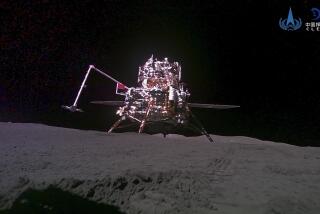Views of Uranus Moon Astonish Space Experts : Voyager 2’s Dramatic Photos of Miranda Reveal Geological Features Scientists Cannot Explain
Stunning photographs of Miranda, the moon closest to Uranus, sent back by Voyager 2 have dumbfounded scientists, who see an astonishing array of geological features on the tiny sphere.
“If you can imagine taking all the bizarre terrestrial features of the solar system and putting them on one object, you’ve got it on Miranda,” Laurence Soderblom of the U.S. Geological Survey said Sunday as the photographs were released in briefings at the Jet Propulsion Laboratory.
The tiny moon--barely 300 miles in diameter--stole the show Sunday with extremely clear photographs showing mountains and valleys and long “race track” type features that scientists are so far unable to explain.
“You name it, we have it,” said Soderblom, deputy leader of the Voyager’s imaging team.
Scientists repeatedly begged off from answering questions about Miranda on Sunday because the photographs so far exceed their expectations that they are reevaluating much of what they had thought about the geological nature of small satellites.
Some of the features found on the tiny moon would be expected on much larger bodies that are subject to strong gravitational and thermodynamic forces, but virtually no one expected to find such a treasure chest on a hunk of ice called Miranda.
And as luck would have it, of all the objects in the Uranian system, Miranda was closest to the spacecraft when it darted--at about 45,000 m.p.h.--past the distant planet Friday morning. Sunlight at Uranus is only about one-four-hundredth as strong as on Earth, thus requiring long exposures of up to 15 seconds.
Scientists had feared that the long exposure time would lead to blurred images, but engineers at JPL worked out a system to lock the camera on the target and then literally let the spacecraft swing freely just enough to match the relative movement of the moon.
The photos of Miranda were the most spectacular development of the day Sunday, but they represented only the tip of a scientific iceberg that scientists will spend years exploring.
The historic nature of the moment was underscored by the chief of the science program of the National Aeronautics and Space Administration, Burton Edelson, who said bluntly that this encounter with Uranus will be a once-in-a-lifetime event for all the scientists who are involved.
A Boost From Saturn
Uranus is 1.8 billion miles from Earth, and Voyager used the gravitational pull of Saturn to fling itself out to the distant planet. That was possible because of an unusual juxtaposition of the planets that occurs only once about every 175 years. Without that gravitational punch, it would have taken Voyager at least 30 years to reach Uranus instead of eight and a half.
“There will not likely be another mission to Uranus for a couple of centuries,” Edelson said. “This is it.”
That means scientists hope to maximize every opportunity presented by Voyager, and although much of the data collected by the spacecraft is yet to be sent back from the on-board recorders, all indications Sunday pointed to a nearly flawless mission. Eleven different experiments collected data on everything from dust particles encountered by the craft as it sped past the planet’s rings to the electromagnetic field that surrounds the planet.
Among the latest discoveries are what appear to be at least parts of up to 10 additional rings around the planet, although they are so faint that they do not show up in photographs from Voyager. They were detected through “stellar occultation,” the measurement of light emitted by a star as the rings pass between the star and the spacecraft. Some of the light is absorbed or deflected by the particles that make up the rings, thus telling scientists that the rings are there although, in the case of those announced Sunday, extremely narrow.
Wins Top Billing
The star of the show Sunday, however, remained Miranda.
“No one could have anticipated the exotic nature of what I’m going to show you this morning,” Soderblom told more than 200 reporters as he unveiled the photographs.
Pictures of the moon Ariel revealed huge “valleys apparently formed by long faults,” but the floors of the valleys apparently have been filled in with something, possibly an ancient “fluid flow,” he said. “Ariel,” like Miranda, “shows a great deal more geological activity than we had expected.”
Miranda is less than half the size of Ariel, and by all accounts it should have been little more than a bland, boring satellite.
Instead, it has deep gorges and massive cliffs. Were it possible to explore one area on foot, Soderblom said, “It would be like walking down the Grand Canyon” and running into a giant sawtooth ridge at the end.
Pancake Formation
Another area, he said, “looks like a stack of flapjacks, quite thin, crepes maybe, plastered on the side of Miranda.”
Another area reveals “a set of ridges that appear to be braided,” he added.
One of the most prominent features consists of a series of shallow valleys that appear as if they were left by the sweeping motion of a giant broom. But the valleys--which one scientist described as “race tracks”--make abrupt 90-degree turns. None of the scientists who have studied the images offered an explanation for the right-angle turns, which do not fit in with conventional geological theories.
Scientists who are working on the images will try again today to make more sense of them, and they expect to release photographs of the darkest of all the major moons, Umbriel.
No one is quite certain yet why the icy moons do not reflect far more light than they do. Umbriel, for example, is so dark that it is hard to see in even the best photographs.
Deepening Puzzle
A number of explanations are beginning to emerge for the lack of luminosity, but so far they are only pieces of the puzzle.
One suggestion is that protons bombarding the surface would, in effect, burn the methane on the top, leaving a darkened residue that would absorb light.
S. M. Krimigis of Johns Hopkins University reported that particles in the radiation belt around the planet reach temperatures of 400 million degrees, but he said the atmosphere is so sparse that “if you were to stick your finger outside it would immediately freeze.”
Frederick L. Scarf of TRW reported that tiny dust particles extend far beyond the outermost rings. Scarf’s experiment measured “something like 30 impacts per second” as Voyager sped through the “ring plane.” The dust particles, measuring less than one-millionth of a meter, vaporized as they hit the spacecraft.
More than 200 scientists are meeting at JPL to study the results from the mission, and they have made no effort to conceal their awe.
Their excitement, said JPL Director Lou Allen, “has really been a marvelous thing to observe.”






